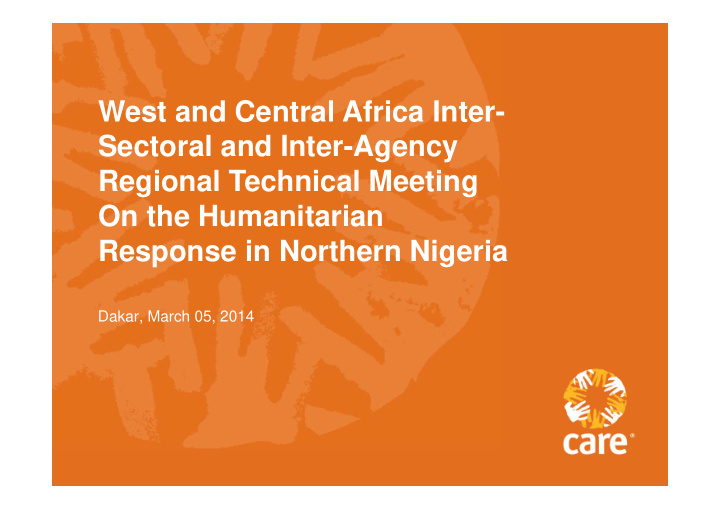



West and Central Africa Inter- Sectoral and Inter-Agency Regional Technical Meeting On the Humanitarian Response in Northern Nigeria Dakar, March 05, 2014
Terms of Reference Three main areas of concern prompted discussions and consensus around the need for a regional in-depth reflection on the present status of the humanitarian response in Northern Nigeria States: 1. The regional consequences of the conflict in Northern Nigeria States in Nigeria’s neighbouring countries, particularly Diffa in Niger, Logone-et- Chari area of Far North Region in Cameroon and Western Chad around Lake Chad. 2. A recognition that planned activities in salient areas of humanitarian concern may not all feature in the Nigeria SRP 3. A concern that stakeholders presently providing support to the humanitarian response in Northern Nigeria States may not all/always have direct visibility on actions on the ground and therefore direct visibility on the quality, outcomes and impact of those actions 1 March 7, 2014
Niger, Diffa Region Last events: • Affected by floods in 2013, last quarter • Classified in stressed food security and in crisis for some pockets • Important to consider that the region is mainly living from the pastoralism • Strong commitment of government of Niger and call for support of the Diffa region (feb 11) 2 March 7, 2014
Niger, Diffa Region Health consequences Populations from Niger and from Nigeria are used to using each others’ territories and services – and have family ties in both countries - this did not change during the March- April crisis, putting a strain on health services in areas of acute short term mobility. Health is presently not really supported except punctually by MSF and ICRC. SAVE implementing a nutrition programme 3 March 7, 2014
Niger, Diffa Region Consequences on pastoralism • Massive return of livestock from Northern Nigeria, bringing epizooties and putting at risk the cattle in Niger • Additional stress on limited water resources for cattle • Pastoralism form North Nigeria are present in a large number in Diffa region where they were not initially transhumant = risk of conflict • Some attacks have been reported near the border • No access to Northern Nigeria pasturage • Lost of access to main markets for cattle initially in Northern Nigeria (eg: Maiduguri, Baga, Malam Fatori, Gaidam) (Source map: USAID Production and market flow 2013/Fewsnet) 4 March 7, 2014
Niger, Diffa Region Food security • Food shortage first due to floods and stressed by new arrivals • Food price remains high (eg Millet price did not decreased during the harvest period) Education Challenges for Nigerian children to attend Francophone system and large number of children are present in Niger due to the ban of school in Northern Nigeria WASH • High risk of water contamination • Pressure on current water facilities 5 March 7, 2014
Niger, Diffa Region Returnees and refugees • Returnees in urgent need of reintegration : food, livelihoods, shelter • Refugees are in host communities but government refused to settle them in camps • UNHCR, WFP and ICRC are providing assistance to them 6 March 7, 2014
North Cameroun (Extreme Nord, Nord and Adamaoua Regions) Last Events: • Recent Nigerian Military operations on Boko Haram near Cameroun border • High Military presence on Cameroun side with the creation of special forces due to the porous border • Permanent insecurity closely to the border and advised restriction for travel in those regions for international • Migration of Cameroons civil servant from the border to towns • Suspicion in the community to hide/host boko haram elements • For some INGOs, suspension of activities in area considered high risk • Affected by floods 7 March 7, 2014
North Cameroun (Extreme Nord, Nord and Adamaoua Regions) Health consequences • Considerable increase of consultation of Nigerian patient in Cameroons health infrastructure = overwhelming of health structures • Main pathologies: diarrhea, malaria Food insecurity (source FAO, Feb 2014) • Remains on major concern in Northern Cameroon exacerbated by the influx of refugees • About 1.7 million people considered food insecure • Reduction of 40% of planted areas • High rate of Chronic malnutrition 8 March 7, 2014
North Cameroun (Extreme Nord, Nord and Adamaoua Regions) Prices, market and Food security • Increase of prices of certain products that are coming from Nigeria • Increase of transportation cost of Bus, Taxi and mototaxi to the road going to Nigeria • Higher pressure on markets on basic items having as a consequence increase of price of essential items and food price speculation The influx of Nigerian population and even Cameroons population moving from border to safer areas have a direct impact on the food security, already fragile in those regions, even in the main town of Maroua 9 March 7, 2014
Lake Chad • No major impact reported • Limited number of refugees 10 March 7, 2014
Thank you ! Merci ! March 7, 2014 11
Recommend
More recommend